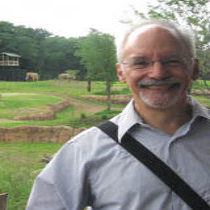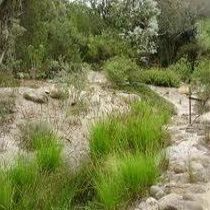Landscape Architecture for Landscape Architects › Forums › PLANTS & HORTICULTURE › Heated Sidewalks and Street Trees
- This topic has 1 reply, 12 voices, and was last updated 14 years, 9 months ago by
Dennis J. Jarrard, PLA, CLARB.
-
AuthorPosts
-
February 23, 2011 at 6:28 pm #164677
 Thomas J. JohnsonParticipant
Thomas J. JohnsonParticipantPerhaps you could suggest / design a cooling tree grate system that pumps freon through a network in the steel, to offset the warming effect of the adjacent sidewalk 😉 This system might have world wide interest in warm climates that want to grow cold climate trees. Tree Refrigerators. You could sell millions of units to Dubai and cover the World Islands in Colorado Blue Spruces, I mean, what’s one more abomination of nature? Right?
February 23, 2011 at 6:30 pm #164676 Rob HalpernParticipant
Rob HalpernParticipantFair question.
Nutty answer:
The local L.A. designed this. They are sub to an out-of-town design firm (architects and L.A.s) who have their own horticultural consultant. She (that consultant) questioned the use of CU soil. That’s all she questioned. So they wanted a second horticultural opinion. I have good history with the Owner and this design firm. I have no idea why such fundamental issues are getting second guessed at this late date.
Turns out, the spec for the CU soil appears flawed (like someone copied it from somewhere and inadvertently deleted a phrase or two properly detailing the soil components. Ouch). So it was easy to point that out and turn it back to their team to figure out what happened there.
As to the choice of tree species, heated sidewalk, etc. I questioned it and left it at that.
But I still want to make sure for my own professional growth that I understand what I can about this situation.
February 23, 2011 at 6:35 pm #164675 Peter BriggsParticipant
Peter BriggsParticipantRob:
The installation in Anchorage did use Silva Cells (Deep Root) with insulation above. They’ve been in 2-3 years now, and seem to be doing quite well. They were a maple tree (Crimson king or similar hardy type if memory serves). For the moment, the trees in the heated sidewalk seem to be doing similarly to the ones installed in a continuous planting bed (12″ish above grade surrounded by seat wall.
It was installed with an air gap too. The other benefit of this is air/soil interchange for gases, biota, etc…
The details of the final installation are unfortunately unknown it seems… no photos during or inspection. One of those things…
p.
February 23, 2011 at 6:38 pm #164674 Peter BriggsParticipant
Peter BriggsParticipantHeh… probably an idea someone might take you up on. One of the questions I do ask myself is to what end do we work “technology” to get trees that will still only live 10 years maybe (hopefully more!). Maybe more permanent urban design/canopies/artwork would fill some of the benefits without the need for a potential commitment to replacement…
p.
February 23, 2011 at 7:40 pm #164673 Thomas J. JohnsonParticipant
Thomas J. JohnsonParticipantThere is a lot to be said for urban tree management. With modern building practices, we need a new approach. Street trees just won’t get as big as they have in the past. As you pointed out earlier, a 4×4 cube is a death sentence for trees. Instead of letting that tree get too big for the space, allowing it to die and then replacing it, it could be transferred to a more appropriate location and a new smaller tree put in it’s place, essentially treating the city as one giant nursery. When the street trees get too big, but before they strangle themselves, they become park // plaza trees… The same could be applied to shrubs, perennials and ground cover. The nurseries might not like it but cities currently have all the plants they’ll ever need if they manage them properly / become their own nurseries…
February 23, 2011 at 7:47 pm #164672 Peter BriggsParticipant
Peter BriggsParticipantInteresting. I think we should also just be honest with ourselves… why do we put trees in places where they can’t achieve their potential in any sustainable fashion? If we want trees in urban areas… they’ll either be miniatures (with your idea being one way to address a form of sustainability)… or we need to provide the green infrastructure to support them. I think I lean to the latter…
I also like the larger context of using urban areas for sustainable forestry practices. When a tree has achieved its optimal value (and begins to slowly age/degrade after that), it could be harvested for its timber value. This is something my forestry professor at the U of Guelph mentioned. In areas that allow growth of high value trees (i.e. walnut), this could be a funding source (i.e. for scholarships if on a University). It’s also a more sustainable management strategy to ensure a mixed and continuous stand of healthy trees.
February 23, 2011 at 8:07 pm #164671 Thomas J. JohnsonParticipant
Thomas J. JohnsonParticipantYeah, I agree… it would be best if we designed environments in which trees could grow big and people / business could flourish. It’s a telling sign when we create spaces for our own inhabitance that can’t support other life forms.
Urban trees as lumber is interesting… why don’t municipalities mandate high-value trees instead of fast-growing? As you mentioned, black walnut is like gold. During the great depression thieves used to take them out of peoples yards in the middle of the night. Just imagine what could be done with a well-managed grove of them in a park setting… or multiplied across an entire city… I think you’re on to something. But like all “big” design ideas… it’s rooted in law.
February 23, 2011 at 9:15 pm #164670Mike G
ParticipantInterestingly enough timber trespass is still common these days, though I haven’t heard of any cases of it for harvesting logs in urban areas. Maybe when the price of lumber goes up and the thrill of jacking copper loses its edge it may take off again.
Reality is it costs too much money to harvest trees in urban areas and there are no lumber mills close to cities. Mulch or bio-mass values do offset the cost but are not profitable alone.
February 23, 2011 at 10:25 pm #164669 Thomas J. JohnsonParticipant
Thomas J. JohnsonParticipantWe’re getting a bit off subject here but…
1. To say it costs too much to harvest trees in urban areas is a sweeping generalization. Is it more expensive to send a team and heavy equipment into the backwoods or to send a few guys with light-equipment into the local park? Is it less expensive to take down trees to grind them into mulch (as is the practice in most cities) than it is to take them down and turn them into lumber or veneer?
2. No lumber mills close to cities!? I looked into getting barn wood milled and there are no less than 4 mills within 45 min. of Chicago.
3. Mulch or bio-mass!? Are we having the same conversation here? We’re talking about Black Walnut not a willow tree that got blown over in a storm.
Thank you for the generalizations with no data to back them up.
Now do the math… in 35 years 1acre will produce 90 Walnut trees worth $10,000 each. That’s $900,000 per acre or about $25,000 a year. Now apply that to 10 acres and you’re looking at $9million dollars or $250,00 yr. Black Walnut tends to outpace inflation by 4-5%. That’s a pretty sound investment. You can diversify your holdings (in case of disease,etc) and grow Cherry trees and Maples that fetch comparable prices. You could also plan your land purchases so that it coincides with development predictions for the area. When you harvest your trees you also sell the land to a developer for significantly more than purchase price. Not bad for doing little more than watching trees grow… You might be too old to enjoy the money yourself but I’m sure your kids and grand kids will appreciate your long-range view… now if we could only get our city planners/managers to see the potential in our parks and open space. Trees could support their bloated pension plans…
http://www.greenwoodnursery.com/page.cfm/22020
The Future We estimate that in 25 years these trees, assuming they’re been properly cared for and planted on good sites, should be worth about $2,000 each. In 30 years they should be worth about $5,000 each. In 35 years they should be worth almost $10,000 each.
Even though the trees are healthy and viable, we recommend being conservative on estimating survival rates. We therefore estimate that one acre should yield 110 trees in 25 years; 100 trees in 30 years, and 90 trees in 35 years.
February 23, 2011 at 11:33 pm #164668 Rob HalpernParticipant
Rob HalpernParticipantGood points, David.
Thank-you
February 24, 2011 at 12:10 am #164667Jay Ryan Courtney
ParticipantI have worked as an arborist through my Landscape Architecture schooling and my old boss has created a company based on the idea of recycling urban timber. He gets his timber from relationships with local tree service companies and the city forestry department. The shelves that our chainsaws would sit on in our shop were even milled from recycled urban timber. I think this idea could ‘grow’ even further for things like park benches and even lumber for construction. MVVA has used recycled timber in Brooklyn bridge park from structures on the site that were disassembled. And it turns out that it was very high quality Yellow Pine used in there benches.
February 24, 2011 at 12:15 am #164666Mike G
ParticipantI don’t mind being off subject if you don’t. When I worked in Chicago in the Urban Foresty and Arboricultural industry people asked me all the time to look at their magnificent walnut trees. ‘This is my retirement’ or ‘Ticket to easy-street’ usually came up in the conversation. But perception is far different than reality. Here is what people actually pay for Black Walnut in Illinois http://web.extension.illinois.edu/forestry/il_timber_prices/pdf/itp_aug2010.pdf
Not every tree can be top veneer grade, especially park or urban trees. So expect average to below average prices. The lumber mills in Chicago are not all that extensive. They handle specialty products and such, but are not equipped to mill veneer or the top dollar products. Most of the highest grade Black Walnut goes overseas, Germany mostly, where they have the demand and technology to put it to use. I guess the demand for dark wood just ain’t what it used to be. Kind of stupid though because of the amount of foreign wood we import into this country.
It is way more costly to harvest trees in urban areas compared to rural areas. From all labor, machine, insurance, efficiency, etc perspectives.
The advertisement you attached does have some good information in it. But I wouldn’t quote it as a source. Remember they are trying to sell you something.
I have heard a while back the city of Milwaukee looked in to this but couldn’t find a way to make it work. One of the southern states Alabama or Louisiana at one point managed forest land along their state highways but the program didn’t run too long before the state had to cut subsidizing it to make it work. I have thought about this type of project and really like the idea, a lot, but it’s economics, and not law, that drives this project. Niche or specialty markets may be out there but not any that meet the economy of scale.
Think about it. If you could really make money on it don’t you think people would already be doing it?
February 24, 2011 at 12:48 am #164665Jay Ryan Courtney
ParticipantI guess this niche market is what I was referring to. It is a way to recycle urban timber that would have other wise gone to the landfill or be chipped into mulch. The wood that my old boss reclaims falls into this category. He has relationships with local Tree companies who call him up when they are removing or trimming trees where the wood may be of interest to him. He is actually getting the timber for free and saving them the cost of chipping or hauling. This must work because Colorado has fewer prized lumber species. It is not worth it for the tree service companies to try and sell the higher quality urban timber at a large scale because it is infrequent that quality lumber is obtainable. The grassroots small time is where things often start. Thats all I was getting at on the off-subject subject.
February 24, 2011 at 9:43 am #164664 AaronParticipant
AaronParticipantA bit off subject, but this interested me, are there many heated side walks around over there!?
February 24, 2011 at 3:15 pm #164663 Thomas J. JohnsonParticipant
Thomas J. JohnsonParticipantMike G – Yeah, I noticed that you have extensive forestry experience. I don’t doubt your knowledge for a second and I think forestry people are some of the neatest people around.
I think the common flaw in attempts at urban forestry is government involvement. When the government runs an operation from the ground-up there is no room for profit and little room for innovation. Government is by definition non-profitable and inefficient at everything they do. They create “positions” fed by tax dollars, not “jobs” supported by entrepreneurial enterprise.
Jays friend has a good model going for him. He has buddies in the tree-service industry and they give him the logs to avoid chipping/dumping. He then mills the logs himself and turns it into expensive high-end furniture. His materials are free and the profit is made on the materials/design/craftsmanship.
Jay – it’s good to hear another story about people in The Fort making a living for themselves, doing what they love and proving that environmentalism and capitalism are not mutually exclusive. I went to CSU for LA and have spent about 8 years there total. Damn, I miss that place…
-
AuthorPosts
- You must be logged in to reply to this topic.


